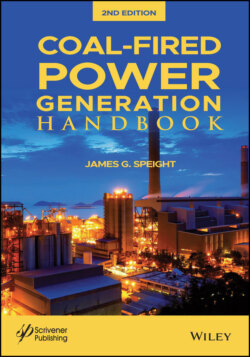Читать книгу Coal-Fired Power Generation Handbook - James Speight G., James G. Speight - Страница 20
1.4.4 Anthracite
ОглавлениеAnthracite (also known as hard coal) is the highest rank of coal (ASTM D388) and is the oldest coal from geological perspective – it is actually considered to be metamorphic. It is a hard coal composed mainly of carbon with little volatile content and practically no moisture.
Anthracite is deep black and often appears to be of a metallic nature because of the glossy surface. Compared to other coal types, anthracite is much harder, brittle, and has a glassy luster, and is denser and blacker with few impurities. When burned, anthracite produces a hot blue flame and, as a result, is primarily used for space heating by residences and businesses in and around the northeastern region of Pennsylvania, where much of it is mined.
Anthracite is considered the cleanest burning of all coal types and produces more heat and less smoke than other coals, and is widely used in furnaces. It is largely used for heating domestically as it burns with little smoke. Some residential home heating stove systems still use anthracite, which burns longer than wood.
Anthracite burns at the highest temperature of any coal and typically produces up to 13,000 to 15,000 Btu per pound. Waste coal discarded during anthracite mining (called culm) and has a heat content has less than half the heat value of mined anthracite and a higher ash and moisture content. It is used most often in fluidized bed combustion (FBC) boilers.
Anthracite has a high fixed carbon value (80 to 95%) (Chapters 2, 5) and a low sulfur as well as a low nitrogen (less than 1% each). Volatile matter is low at approximately 5% w/w, with 10 to 20% w/w of mineral ash produced by combustion. The moisture content is approximately 5 to 15% w/w and the coal is slow-burning and difficult to ignite because of the high density – consequently few pulverized coal-fired plants use anthracite as the fuel.
Anthracite is considered non-clinkering and free burning because (when ignited) it does not coke or expand and fuse together. It is most often burned in underfeed stoker boilers or single-retort side-dump stoker boilers with stationary grates. Dry-bottom furnaces are used because of the high ash fusion temperature of anthracite. Lower boiler loads tend to keep heat lower, which in turn reduces nitrogen oxide emissions.
Particulate matter, or fine soot, from burning anthracite can be reduced with proper furnace configurations and appropriate boiler load, under-fire air practices, and fly ash reinjection. Fabric filters, electrostatic precipitators (ESP), and scrubbers can be used to reduce particulate matter pollution from anthracite-fired boilers. Anthracite that is pulverized before burning creates more particulate matter.
Furthermore, it is worthy of note that even in the terminology of anthracite there are several variations which, although somewhat descriptive, do not give any detailed indications of the character of the coal. For example, some of the terms which refer to anthracite are: black coal, hard coal, stone coal, which should not to be confused with the German steinkohle or the Dutch steenbok, which are terms that include all varieties of coal with a stone-like hardness and appearance, blind coal, Kilkenny coal, crow coal (from its shiny black appearance), and black diamond. However, as the importance of the coal trade increased, it was realized that some more definite means of classifying coals according to their composition and heating value was desired because the lines of distinction between the varieties used in the past were not sufficiently definite for practical purposes (Thorpe et al., 1978; Freese, 2003).
Anthracite is scarce and only a small percentage of all remaining coal resources are anthracite. Pennsylvania anthracite was mined heavily during the late 1800s and early 1900s, and remaining supplies became harder and harder to access because of their deep location. The largest quantity of anthracite ever produced in Pennsylvania was in 1917.
Historically, anthracite was mined in a 480-square-mile area in the northeastern region of Pennsylvania, primarily in Lackawanna, Luzerne, and Schuylkill counties. Smaller resources are found in Rhode Island and Virginia.
